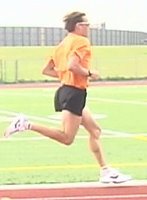More on Running Faster
As mentioned in a previous post on running faster, I have the triathletes I coach do some form of the basic strides drill year round. As with swimming, it seems you can never devote too much time to improving your run technique. I once coached a pro triathlete who was an All-American runner in college and considered one of the fastest runners in triathlon. I still had him work on technique year round. You should too.
The downhill strides workout described in the original running faster post is very simple. All you do is run fast for 20 seconds several times on a soft surface such as a grassy park that has a very slight decline (such as 1%). If you do not have a history of calf, Achilles or plantar fascia injuries then I'd have you substitute “uphill strides” for the downhill strides workout after a few weeks.
This session will help you develop more running force. As explained earlier, there are only two things you can do to run faster - increase your stride length or increase your cadence. What you would really like to do is both. In that previous post I described how to improve your cadence. Let's now look at how to improve stride length which is just another way of saying improve force.
Developing greater running force will make your stride longer without even trying. Combine that with the higher cadence you have been working on with downhill strides and your running is sure to improve. But it won’t happen overnight. Your aerobic system must also improve to allow you to maintain the combined higher cadence and longer stride. And the nervous system must also adapt to the changes. All of this will take some time as the aerobic and nervous systems change slowly. By the start of the Build period in a few weeks, if you’ve been diligent about both speed skills and force training, you will be running faster at the same effort as when you started Base training. You must be patient and persistent to realize the improvement. In the mean time, don't try to artificially increase your stride length while running. Let it happen naturally.
Uphill strides workouts for force are done on either a short, very steep hill or on something like the stairs you find in a football stadium or basketball arena. If you have had some Achilles, calf or plantar fascia injuries then you are better off using the stairs - if you do this workout at all. The ankle flexion is significant when running up a steep hill and puts a tremendous load on those soft tissues. For this reason I prefer stairs for this workout for most runners but they are harder to find than hills.
The uphill strides workout is simple. Warm-up well and then do three sets of three intervals up the hill or stairs. Run as hard as you can on each interval – but not so hard that your technique breaks down. If running stairs you may need to take two or even three steps with each stride depending on the width and rise of the stairs. Count 12, right-foot strikes stopping on the twelfth. Turn around and walk back down the hill or stairs. Do not run down. Jog easily for five minutes after each set.
This is a very risky workout. Be cautious with its progression. Do this no more than twice a week with at least 96 hours between them. Once a week is better for most athletes. Start with one set and add another each week for three weeks. If you have “glass legs” you would be wise not to do it at all. In that case just continue doing the downhill strides for speed skill. Not all of the athletes I coach do the uphill strides workout. I’m very conservative when it comes to risky running workouts. You must avoid injury.
Labels: cadence, force, hills, running, stride length, strides


